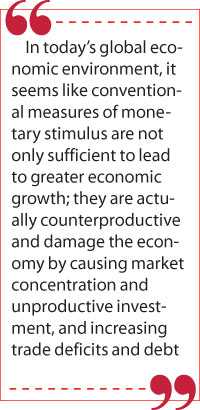Thursday Dec 18, 2025
Thursday Dec 18, 2025
Thursday, 7 January 2021 00:00 - - {{hitsCtrl.values.hits}}

Fiscal and monetary authorities in Sri Lanka have undertaken unprecedented steps to revamp the fragile economy during the pandemic situation through massive fiscal stimulus and easing monetary regulations to uplift the nation. Reaping the benefits is in the hands of all economic sectors and individuals of a positive approach to recuperate the economy of the country
 The movement of interest rates spread led by the pandemic in world economy
The movement of interest rates spread led by the pandemic in world economy
When compared to other countries it has been observed that the interest rates spread for Sri Lankan commercial banks are much higher reflecting high intermediation cost incurred by local commercial banks. The banking sector has been developing gradually over the years in terms of number of banks, number of branches, assets and in terms of the usage of technology in customer service.
However, banks so far have been unable to reduce considerably their intermediation costs, and hence the problem of high interest rates spread exists. Gaining a clear understanding about the factors that influence the interest rates spread would help effective policymaking.
Global economy landscape has reshaped with an everlasting impact with the surge of COVID-19 pandemic. It is anticipated that most of the developed and emerging economies will plunge in to a recession in 2020 and beyond, contracting major portion of GDP ever since 1870s.
The reduction of interest rates, stimulus packages backed by respective governments together with unconventional monetary policy measures have been included to the day today vocabulary. It has been envisaged a 5.2% contraction in global GDP in 2020, the deep recession ignited in global economy with the pandemic across the world.
In response to the pandemic-induced global recession, monetary authorities across the world have commenced to introduce lower interest rates – with Eurozone, Switzerland, and Japan already in the negative interest rates zone and the US Federal Reserve seemingly heading in the same direction. Global stock markets tanked in March 2020.
For a time even US Treasury bonds, the world’s safest asset, fell in price amid a scramble for cash and turned into dysfunctional money markets. The Federal Reserve in USA cut interest rates and unleashed a torrent of liquidity to keep dollar markets functioning, preventing a credit crunch, mass bankruptcies and lay-offs.
Other central banks followed suit. From the beginning of year 2020, Central Banks in the US, UK, Japan and the European Banking sector have created new money worth of $ 3.8 trillion, much of which have kept yields on long-term Government debt close to zero.
Navigation of interest rates in Sri Lankan context amid COVID-19
Considering the necessity to further support the economy to endure the adverse economic impact caused by the COVID-19 pandemic, given subdued inflationary pressures, the Central Bank of Sri Lanka (CBSL) has decided in addition to the other measures taken to ease monetary conditions in the market, to reduce the Standing Deposit Facility Rate (SDFR) and the Standing Lending Facility Rate (SLFR) of the Central Bank by 50 basis points to 5.50% and 6.50%, respectively, effective from 6 May.
Additionally with the objective of revamping the affected businesses by the COVID-19 pandemic, the CBSL, in consultation with the Government of Sri Lanka, implemented Saubagya COVID-19 Renaissance Loan Scheme Facility in three phases to provide working capital loans at a lower interest rate of 4% per annum, with a repayment period of 24 months, including a grace period of six months and subsequently granted extension period of repayment considering the turbulent situation and constraints of repayment arisen with the second wave of the pandemic. 
Further backing lower interest rates as the best growth formula, the CBSL last week decided banks would change 7% p.a. on mortgage backed housing loans and would introduce lending targets to selected sectors to counter the second COVID-19 wave. The Monetary Board at its last monetary policy announcement for this year kept policy rules unchanged and decided to introduce two new measures to complement the concessional loan scheme proposed by the Budget 20/21.
Yet fulfilling its national duty as the regulator of the economy, the CBSL has decided to reduce the Statutory Reserve Ratio(SRR) applicable on all rupee deposit liabilities of licensed commercial banks (LCBs) by 200 basis points to 2.00%, with effect from the reserve maintenance period that commenced on 16 June.
This reduction in the SRR injected around Rs. 115 billion of additional liquidity to the domestic money s market, enabling the financial system to expedite credit flows to the economy, while reducing the cost of funds of LCBs.
The financial sector is expected to pass the benefit of the high level of liquidity and the reduced cost of funds to the economy without delay, by increasing lending to businesses and households at low cost. The Monetary Board will continue to monitor economic and financial market developments and will take further policy and regulatory measures to support a sustained revival of economic activity in the period ahead.
Monetary policy and control its money supply, often mandated with maintaining low inflation and steady GDP growth. On a macro basis influence interest rates and participate in open market operations to control the cost of borrowing and lending throughout an economy. Thus the regulators extended their duty to the interest of the nation in relaxing monetary policy guidelines with the objective of infusing additional liquidity to the economy during this strenuous situation.
However, instead of investing the funds which obtained at an incentive low rate, the manipulation and diversion of additional funds could be witnessed and thus a liquidity trap has awaken which hinders the normal function of spurring the economy to growth.
At this juncture the role of the regulator is vital to influence interest rates in the economy, affecting the behaviour of borrowers and lenders, economic activity and ultimately the rate of inflation.
However the issue is not entirely above level of market liquidity. It is more about structural deficiencies within the banking sector such as high tendency for transferring facilities to Non Performing (NPL) category since most of the businesses and individuals tend to exploit the incentive of low interest rate by acquiring more consumption rather than investing funds to the affected businesses.
Therefore, it is indispensable to identify the needy sectors and follow the end use of funds through a comprehensive monitoring mechanism. Also it is prudent to manage moderate rate for consumption as such misappropriation of funds is expected to be minimised.
The reduction in interest rates will improve the repayment capacity of borrowers, strengthen licensed banks and address the challenges of rising NPLs. Also the banks could establish Business Revival Units in order to reduce NPLs by granting additional loans on lower rates for the purpose of recovering hardcore facilities.
In today’s global economic environment, it seems like conventional measures of monetary stimulus are not only sufficient to lead to greater economic growth; they are actually counterproductive and damage the economy by causing market concentration and unproductive investment, and increasing trade deficits and debt.
Central Banks have already realised their importance in contemporary conditions and time to time in supervision, the Central Banks assess the risks that financial institutions pose to financial system stability and, where necessary, take actions to reduce them.
Despite the fact that the interest rate cuts should support economic growth, they alone may not be substantial enough to offset the impact of sluggish growth of economy. The cost of financing may not be the main factor deterring businesses from investing. Therefore this should be a wake-up call for countries to take efforts towards diversifying their economic base to avoid daunting vulnerabilities of low interest rates and get benefited as expected by the policy makers.
Expectation vs. Reality
The conservative insight is that low interest rate is positive for economic growth because it paves the way for governments, businesses, and consumers to borrow hence spurring investment and ultimately increasing employment and GDP growth. However, it is ambiguous that current lowering of interest rates would boost investment and which in turn assist to revive the economy.
In spite of everything, the current issues in the world economy are the repercussions led by the pandemic, both on demand and supply, as it disrupted global supply chains, restricted people movement and closure of borders.
In this backdrop, it is unlikely that rate cuts will generate productive investments at a time when business entities prefer to save rather than to invest not due to high costs of borrowing and “high” interest rates but because of the uncertainty associated with the pandemic.
Also, particularly when the lower rates introduced for consumption loans such as housing, purchasing capital items, education etc, it is doubtful that funds would be utilised for the same purpose. Therefore, diverting funds will be a common lapse made by the borrowers with the financial constraints followed by the pandemic.
According to the latest researches, it has been stated that low interest rates, instead of higher contribution towards the economic growth, have contractionary consequences due to increased market concentration and subsequent formation of monopolies.
As the authors of the researches claim, “lowering interest rates have an expansionary effect on the economy through stronger productivity growth”. However, although lower interest rates encourage all firms in a sector to invest further, the incentive has been grasped by market leaders than followers.
As a result, industries become more monopolistic over time as long-term rates fall. The various studies concluded that low interest rates would lead to monopolisation of the economy, slowing growth in productivity, and rising inequality rather than stimulating the development of the economy.
However, it has been witnessed in today’s context particularly in economies in South Asian Region which have low or moderate per capita income that traditional monetary measures is no longer assist in reviving the economy. They contribute in rising inequality for lower interest rates benefit mostly the wealthy, who possess large financial holdings, and hurt middle-class families and retirees who depend on their investments and savings for a living.
Low interest rates, by spurring the growth in consumption, reduce national savings. In turn, in the long run the reductions in national savings directly root to the current account imbalances, in particular, trade deficits and subsequent fiscal deficits.
At the instance of paying incentives of low interest rates to the economy, the banks and other financial institutions may overinvest in long-term assets, such as Treasury securities. If interest rates rise unexpectedly, the value of those assets will fall exposing banks to substantial losses.
However, it is affirmed that in this circumstance, lower interest rates would be a favourable factor in improving bank balance sheets and banks’ capacity to lend. During the financial crisis, many banks, particularly some of the largest banks, were found to be undercapitalised, which limited their ability to make loans during the initial stages of the recovery. Therefore, in terms of augmenting the bank balance sheet at the turbulent economy, this would be a blessing in disguise.
Fiscal and monetary authorities in Sri Lanka have undertaken unprecedented steps to revamp the fragile economy during the pandemic situation through massive fiscal stimulus and easing monetary regulations to uplift the nation. Reaping the benefits is in the hands of all economic sectors and individuals in positive approach to recuperate the economy of the country.
(The writer is currently steering the Corporate and Offshore Banking Division of Bank of Ceylon as the Deputy General Manager (Corporate and Offshore Banking) who is a senior banker counting over 29 years’ experience in both local and international banking arenas. He holds a Bachelor’s (Special) Degree in Public Administration and Master of Science (M.Sc) in Management specialising in Banking and Finance, both from the University of Sri Jayewardenepura, Sri Lanka. Also he is an Associate Member of the Institute of Bankers of Sri Lanka.)